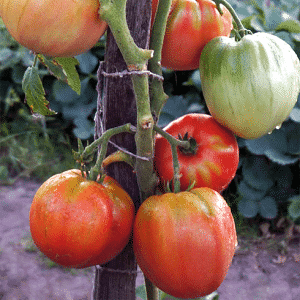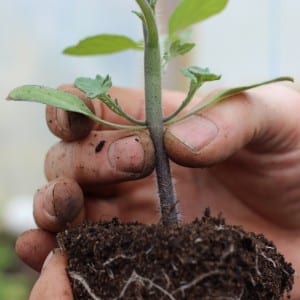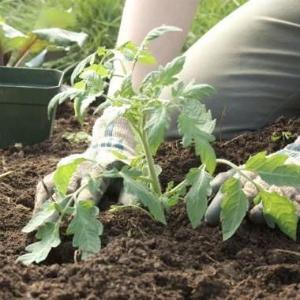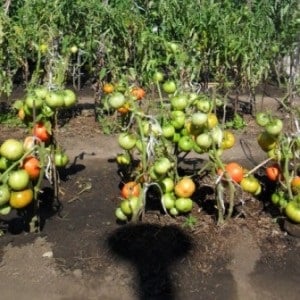An excellent variety for fresh consumption is the Portuguese Dacosta tomato and the features of its agricultural technology
Large-fruited pink tomatoes are considered ideal for making salads and eating fresh. They have a rich sweet taste and a pronounced tomato aroma. These are the fruits that are most in demand in grocery and horticultural markets.
The Portuguese Dacosta tomato stands out against the background of many other pink-fruited varieties. It is distinguished not only by its giant berries with excellent taste, but also by its high yield. Growing such tomatoes is not difficult due to their increased resistance to adverse environmental factors.
Description of the variety
Portuguese Dacosta is a varietal tomato bred by Portuguese breeders. It is a rare variety and is not sold in all stores.
In 2017, the Portuguese Dacosta tomato entered the top ten best tomato varieties. It is not easy to get its seeds, but if you buy them once, planting material can be constantly taken from the fruits.
Distinctive features of the Portuguese Dacosta
Portuguese Dacosta is a pink-fruited tomato. Produces large fruits. Some specimens reach a weight of 1000 g.
A characteristic feature of the fruits of this variety is their fleshiness. The berries contain a large amount of juicy but tender pulp. The tomatoes taste sweet, with barely noticeable sourness. They have a characteristic and rich tomato aroma.
The variety is immune to most tomato diseases. He does not suffer from root and crown rot, late blight and tobacco mosaic.
Another feature of the Portuguese Dacosta is its resistance to temperature changes. These tomatoes are suitable for growing even in open ground conditions.
A negative feature of the variety is the tendency of the fruits to crack. The larger the berries, the higher the likelihood of damage to them.
General characteristics
Portuguese Dacosta is sold mainly in online stores. This is a rare collectible variety. Often its planting material, collected from their own harvest, is sold by gardeners.
Tomato fruits contain a minimal amount of small seeds. To prepare seeds for the next planting, the largest and most beautiful berries are left on the bush until fully ripe.
Description and characteristics of the variety:
| Parameter | Indicators |
| Bush type | Indeterminate tomato. Height varies between 1.8–2 m. The bushes are medium-leaved, not spreading. The leaves are simple, medium-sized, rich green, without pubescence. The fruits are set in clusters. Each of them produces 3–5 berries. The inflorescences are simple. |
| Growing method | It is possible to grow in open and protected ground. The tomato is resistant to temperature changes. |
| Productivity | High. Up to 7 kg of berries are harvested from one bush. From 1 sq. m get up to 20 kg of harvest. |
| Fruit | Big size. One berry weighs on average from 300 to 500 g. There are specimens weighing up to 1 kg. At maturity, bright pink in color. There is no green spot at the base, but lighter spots may be present. The pulp is dense but juicy. The berries taste sweet, with a slight sourness and tomato aroma. The shape is round, flattened on both sides. There is pronounced ribbing at the base. There are many small chambers in tomatoes, more than 8.They contain a small amount of seeds. |
| Transportability | The fruits are suitable for transportation over long distances, but are stored for no more than three weeks. |
| Ripening time | Mid-season. The first berries ripen 115–120 days after sowing the seeds. |
| Disease resistance | Immunity to tomato diseases is high. |
How to grow seedlings
Portuguese Dacosta is grown only by seedlings. When sowing seeds directly into the ground, the crop will not have time to ripen before the onset of frost.
Sowing time depends on the region:
- cities with a hot climate - end of April;
- central Russia - second half of April;
- northern regions – early April.
If you plan to plant tomatoes in a greenhouse, then start growing seedlings two weeks earlier.
Preparation of planting material
To obtain healthy plants with increased resistance to adverse environmental factors, they must be pre-treated:
- The seeds are soaked in salt water (1 teaspoon of salt per 1 cup of water) for half an hour. Specimens that float to the surface will not rise.
- Planting material is disinfected. It is soaked in a solution of soda (1 teaspoon per 1 cup of water) for 12 hours, in a light pink solution of potassium permanganate for 30 minutes, in hydrogen peroxide for 15 minutes or in aloe juice for 12 hours.
- To stimulate growth, seeds are soaked in commercial preparations (Epin, Sodium Humate), in a soda solution, aloe juice, or wrapped in damp gauze, placed in a warm place and germinated.
Container and soil
Tomatoes need light and nutritious soil. Suitable mixtures are sold in stores. Both a universal soil mixture and a special one for tomatoes and peppers are suitable.
They prepare the soil themselves. To do this, mix the base, nutrient substrate and baking powder.For example, garden soil (it is better to take it from the beds where you plan to grow tomatoes), peat and sand.
The soil is disinfected. She's being watered copper sulfate, light pink solution of potassium permanganate or boiling water. Another option is to calcine the soil in the oven.
Portuguese Dacosta is usually sown directly into individual containers. This is a collectible variety that needs to be handled carefully. It is better to take peat tablets. Plastic and peat pots or disposable cups are also suitable.
Important. Peat containers are not pre-disinfected. Plastic pots are soaked for half an hour in a dark pink solution of potassium permanganate.
Sowing seeds
1-2 seeds are sown in pots. They are buried 1-1.5 cm. The soil is watered before planting tomatoes.
Containers with planting material are covered with film and put in a warm place. The warmer the room is, the faster the seeds will germinate. At this stage, tomatoes do not require light.
Every day, the film or glass is opened slightly for 1 hour to prevent mold from forming on the soil.
It is more convenient to grow seedlings in peat tablets. They are filled with ready-made nutrient substrate. The seeds germinate quickly in them. When picking to a permanent place, there is no need to remove seedlings from such preparations.
Before use, the tablets are soaked in boiling water, adding liquid as they swell. Then a seed is sown in each workpiece, deepened by 1 cm.
Peat tablets with planting material are placed in a deep container. They are covered with film and placed in a warm place until the seeds germinate.
Seedling care
Good seedlings should be stocky, bright green, strong and have short internodes. To obtain such plants, they are provided with proper care:
- Water the seedlings with settled water at room temperature. The liquid is poured under the root of the plant so that it does not fall on the ground part of the bush. The soil is moistened as the top layer dries. If watered incorrectly, tomatoes become wilted. This happens both when the soil is over-moistened and when it dries out.

- After seed germination, the film is removed. Plants should be at room temperature. If they stand in a draft, this will lead to death. Tomatoes need 16 hours of daylight. The lack of lighting is compensated by fluorescent lamps.
- Fertilizing is applied three times during the entire period of growing seedlings. They use complex fertilizers containing phosphorus, which promotes the development of a strong root system. The first fertilizing is applied after the formation of the second true leaf, the next - every two weeks.
- It is recommended to grow Portuguese Dacosta seedlings without picking.
- 10 days before planting in a permanent place, the plants begin to harden. They are taken out into the air in the warm season for 1-2 hours, and their exposure to air is gradually increased.
Rules of agricultural technology of the Portuguese Dacosta
Portuguese Dacosta is planted in open ground when the soil at a depth of 15 cm has warmed up. It is important that by this time the threat of return frosts has passed.
By the time of planting, the seedlings should be 45–55 days old. If the plants are left too long, they will not take root well in the new location.
Landing at a permanent place
Choose a well-lit place for tomatoes. The beds are not placed in areas where groundwater is close to the surface and where no other nightshade plants have grown there in the previous two years.Tomatoes feel best after melons and melons.
Before planting tomatoes in a new place, the beds need to be prepared. In the fall, they are dug up and cleared of all plant debris. Fertilizers are added to the soil. For example: humus, rotted cow manure or chicken droppings. If the acidity is high, the soil is mixed with ash.
In spring, the beds are leveled with a rake and cleared of weeds. They are watered with chicken droppings diluted with water 1:10 and hot copper sulfate.
Advice! It is recommended not to throw away weeds collected from the beds, but to process them into organic fertilizers. To do this, the grass is placed in a barrel, poured with boiling water and infused. To speed up fermentation, sugar or jam is added to the mixture.
Holes are dug in the beds. Number of holes per 1 square. m depends on how many trunks are planned to be left for the plants. When growing in one stem, up to 4 plants are planted in this area; when growing in two stems, no more than 3.
Pour 1 liter of light pink solution of potassium permanganate into each well and add 1 tbsp. l. ash. When the liquid is absorbed, plants removed from the containers (if these are not peat tablets and pots) are planted in the recesses along with a lump of earth. The holes are filled with soil and compacted.
The plants are not watered or fed for two weeks. During this time, they will take root and take root in a new place.
Basic rules of care
 The Portuguese Dacosta needs a garter. The bushes are attached to a support as they grow. They use synthetic thread - it is not subject to rotting. Since this variety has large and heavy fruits, it is additionally tied to supports and brushes.
The Portuguese Dacosta needs a garter. The bushes are attached to a support as they grow. They use synthetic thread - it is not subject to rotting. Since this variety has large and heavy fruits, it is additionally tied to supports and brushes.
Form tomatoes into one or two stems.The weight of the berries directly depends on the number of stems left to the plant. The fewer stems there are, the larger the fruits will be and the sooner they will ripen.
At stepsoning remove all leaves up to the first flower cluster. Remove withered and yellowed greens. The procedure is carried out once a week, removing no more than three leaves.
Water the tomatoes as the soil dries. One plant consumes 2-3 liters of water.
Portuguese Dacosta responds well to feeding. With regular fertilization, tomatoes turn out tastier and larger. It is recommended to feed this variety every two weeks.
Foliar boron feeding applied twice per season. The first time is before the tomato blooms. Take 10 g of boron and dilute it in 10 liters of water. Bushes are sprayed with this mixture. The second feeding is carried out during the period of fruit formation, then the tomato will ripen faster.
Features of cultivation
When growing Portuguese Dacosta, gardeners should consider several nuances.
- To get large fruits, the ovaries need to be thinned. No more than three berries are left on one bunch.
- The fruits of the Portuguese Dacosta are prone to cracking. They are damaged by too much watering and when the soil dries out. Therefore, tomatoes are watered no more than 2 times a week in open ground and 1 time every 7 days in a greenhouse. Use 2-3 liters of liquid per plant.
- On hot days, to prevent fruits from cracking in open ground, a canopy is placed over them.
- To get more berries, the bushes are shaken regularly.
Diseases and pests
Portuguese Dacosta is characterized by increased immunity to tomato disease. Despite this, experienced gardeners advise not to neglect the rules of prevention:
- Disinfection. A dark pink solution of potassium permanganate or hot copper sulfate is used to treat the soil, greenhouse walls and garden tools.
- Follow the rules of crop rotation. Nightshades leave behind infections in the soil that infect new tomato plantings.
- Potatoes should not be planted next to tomato beds. This plant attracts pests.
- It is recommended to plant aromatic herbs between the beds with tomatoes. (rosemary, thyme or basil). They repel harmful insects and attract beneficial ones.
- To wash off aphids from the bushes, they are sprayed with a decoction of wormwood. Infusions of other herbs with a bitter taste are also suitable. Another option is to prepare a soap-pepper solution. To do this, add a piece of grated laundry soap and 5 hot peppers twisted in a meat grinder to a bucket of water.
The nuances of growing in open ground and in a greenhouse
When growing in a greenhouse, crop rotation must also be observed. In this case, in the beds where nightshade crops previously grew, the soil is simply changed.
The walls of the greenhouse are treated with copper sulfate. To reduce the likelihood of infections spreading throughout the room, it is regularly ventilated.
This is interesting! For several years now, experimental gardeners have been claiming that pyramid-shaped greenhouses produce healthier and more productive plants.
In open ground, there is a high risk of death of tomatoes due to night frosts. To prevent this from happening, the beds are covered with film every evening for the first two weeks after planting.
Harvesting and application
 The first berries of the Portuguese Dacosta are harvested in the second half of July. They are plucked individually, since this variety does not differ in its ripening speed.
The first berries of the Portuguese Dacosta are harvested in the second half of July. They are plucked individually, since this variety does not differ in its ripening speed.
The fruits of the Portuguese Dacosta are mainly consumed fresh.These tomatoes make delicious juices and sauces. They are not suitable for fresh preservation due to large plants and loose skin.
Advantages and disadvantages of the variety
Advantages of the Portuguese Dacosta:
- immunity to tomato diseases;
- large fruit;
- high productivity;
- wonderful taste of fruits;
- the ability to use seeds from your own harvest for planting.
The disadvantages include the need for gartering and pinching of bushes. Another disadvantage is that the seeds are difficult to find.
Farmer reviews
Reviews from gardeners about the Portuguese Dacosta are definitely positive. Everyone who has tried this tomato plants it again.
Alisa, Zelenograd: “This is my third year growing Portuguese Dacosta. The seeds were given by a neighbor in the area. Very tasty tomatoes and a large harvest. I form it into one stem, so the tomatoes turn out larger. I collect seeds from berries that ripen on the bush, even though there are very few of them there. It’s a pity to use it for juices; everything is eaten fresh.”
Ivan, Shumerlya: “Last year I planted Portuguese Dacosta. Formed into two stems. There were a lot of tomatoes, but the first ones cracked. I think this is due to frequent rains. The berries taste sweet, with a pleasant sourness and a pronounced tomato aroma. They turn out large and beautiful, just like in the photo.”
Conclusion
Portuguese Dacosta is one of the best pink-fruited varieties. It is loved by gardeners due to the gigantic size of its berries, excellent taste and high yield. Ideal for preparing salads, sauces and juices.
The variety is a rare collectible. Not sold in all gardening stores, which makes them difficult to obtain. But seeds from the fruits of your own harvest are suitable for planting.
Growing these tomatoes is not difficult. They are distinguished by increased immunity to diseases and infections, and are not afraid of temperature changes. It is only important to monitor humidity and temperature to prevent cracking of the fruit.